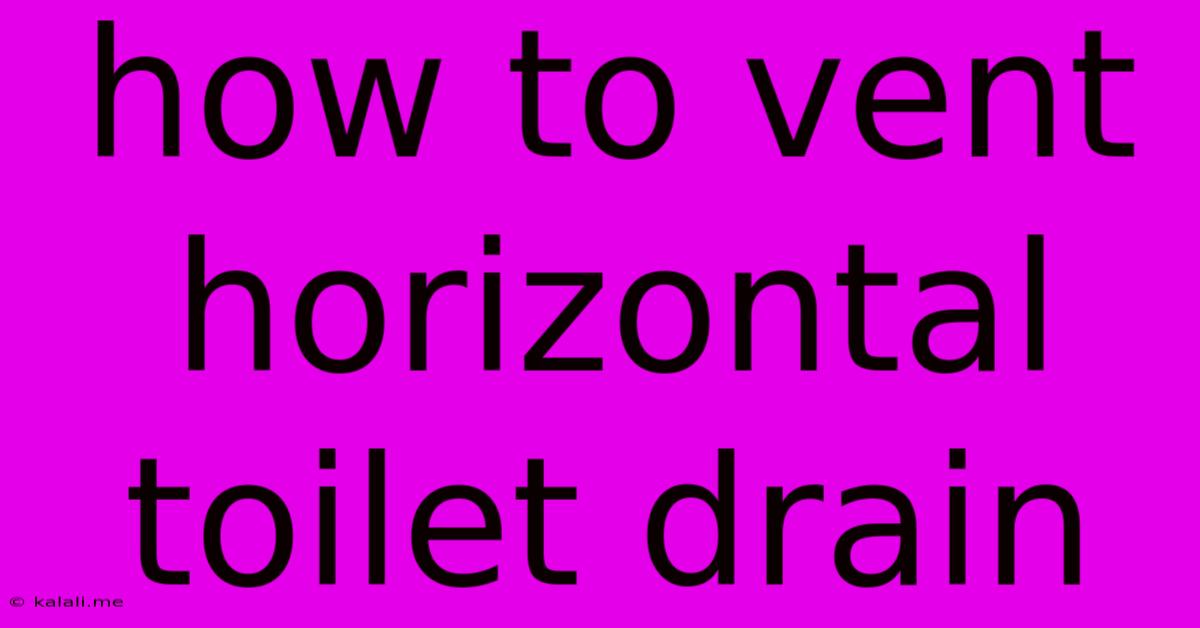How To Vent Horizontal Toilet Drain
Kalali
May 23, 2025 · 4 min read

Table of Contents
How to Vent a Horizontal Toilet Drain: A Step-by-Step Guide
Vent pipes are crucial for proper plumbing function. They prevent siphoning, ensure efficient draining, and stop sewer gases from entering your home. A poorly vented toilet can lead to slow flushing, gurgling sounds, and even sewer backups. This guide will walk you through the process of venting a horizontal toilet drain, a task best undertaken with basic plumbing knowledge or the help of a professional. Always turn off the water supply before starting any plumbing work.
Understanding the Importance of Venting
Before we dive into the specifics, let's understand why venting is so important. When you flush a toilet, water rushes down the drain. Without a vent, the air pressure in the drain line drops, creating a vacuum that can siphon the water out of the toilet bowl, leaving it unable to flush effectively. The vent allows air to enter the system, equalizing pressure and preventing this siphoning effect. A properly vented system also prevents unpleasant sewer gases from escaping into your bathroom.
Identifying Your Plumbing System
Before beginning any work, carefully inspect your existing plumbing to determine the layout. You need to identify the drain line from your toilet and trace it to determine where it connects to the main drain stack. This will help you determine the best location for your vent pipe. Understanding the existing configuration will help you plan the most efficient venting solution. Consider taking photos or sketching a diagram to aid your understanding. Knowing if you're working with PVC, ABS, or another material will also guide your choice of fittings.
Materials and Tools You'll Need
You will likely need the following materials and tools. The exact quantities will depend on your specific plumbing configuration and the length of the vent pipe required:
- PVC or ABS pipe: Choose the appropriate diameter pipe (usually the same as your drain line).
- PVC or ABS fittings: This includes elbows, tees, and possibly a vent cap.
- Pipe cutter or saw: For clean cuts on your pipes.
- Primer and cement: For securely joining the PVC or ABS pipes and fittings.
- Measuring tape: For accurate measurements.
- Level: To ensure your vent pipe is properly installed.
- Drill (if necessary): To drill holes in walls or ceilings.
- Safety Glasses: To protect your eyes from flying debris.
- Gloves: To protect your hands from chemicals.
Step-by-Step Installation Guide
This is a general guide, and your specific situation may require variations. If you are uncomfortable with any of these steps, it's best to consult a professional plumber.
-
Locate the appropriate vent location: This is typically above the highest fixture on the horizontal drain line, usually in the attic or the roof. This allows for proper air circulation and prevents clogs.
-
Cut and prepare the pipes: Measure and cut your PVC or ABS pipe to the appropriate length, ensuring a snug fit. Clean the pipe ends thoroughly before applying primer and cement.
-
Install the vent pipe: Carefully connect the vent pipe to the drain line using the appropriate fittings (typically a tee). Ensure all joints are secure and properly cemented. Maintain a consistent slope to ensure proper drainage.
-
Extend the vent to the roof (if necessary): Route the pipe through the attic or ceiling, ensuring it is properly supported and secured to prevent sagging or damage. If necessary, use appropriate fasteners and supports.
-
Install the vent cap: Once the vent pipe reaches the roof or a suitable outdoor location, install a vent cap to protect against debris and insects.
-
Test the system: Turn the water supply back on and flush the toilet several times. Listen for gurgling sounds or slow draining, which indicate potential issues. Check for leaks around all joints.
Troubleshooting Common Problems
- Slow Draining: This could be due to a clog in the drain line, improper venting, or a low slope in the piping.
- Gurgling Sounds: Gurgling usually points to a venting problem; insufficient venting can create negative pressure.
- Leaks: Check all joints for proper sealing and re-cement as necessary.
Disclaimer: This guide provides general information and should not be considered professional plumbing advice. Always prioritize safety and consult with a qualified plumber if you're unsure about any aspect of this process. Improper installation can lead to serious plumbing issues, and professional help ensures a safe and correctly functioning system.
Latest Posts
Latest Posts
-
At The Drop Of A Dime
May 23, 2025
-
What Does Run Me Like A River Mean
May 23, 2025
-
Encrypt To Random Number Website Generator
May 23, 2025
-
How To Check Continuity With A Multimeter
May 23, 2025
-
Cvc Elt 1 A Cannot Find The Declaration Of Element Flow
May 23, 2025
Related Post
Thank you for visiting our website which covers about How To Vent Horizontal Toilet Drain . We hope the information provided has been useful to you. Feel free to contact us if you have any questions or need further assistance. See you next time and don't miss to bookmark.